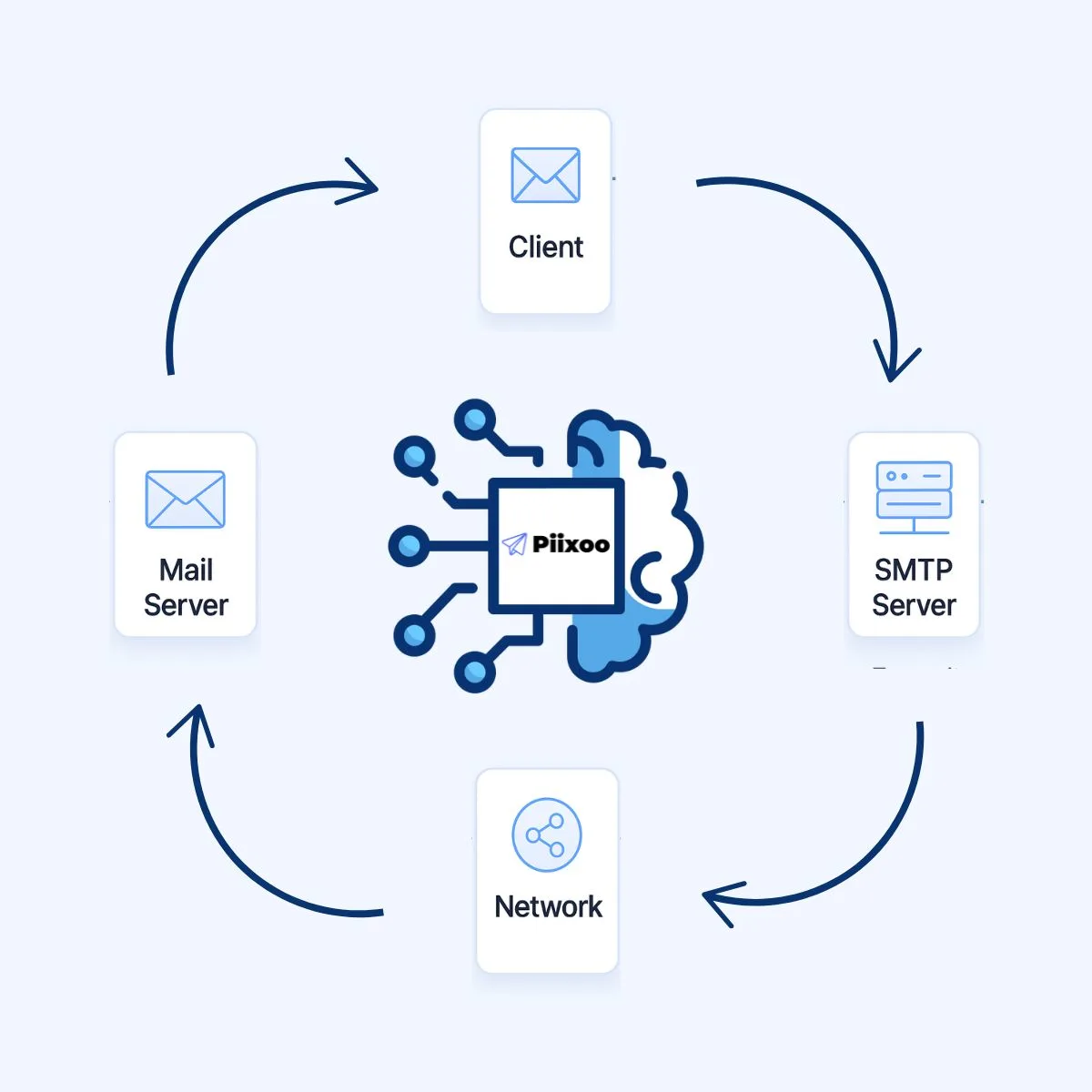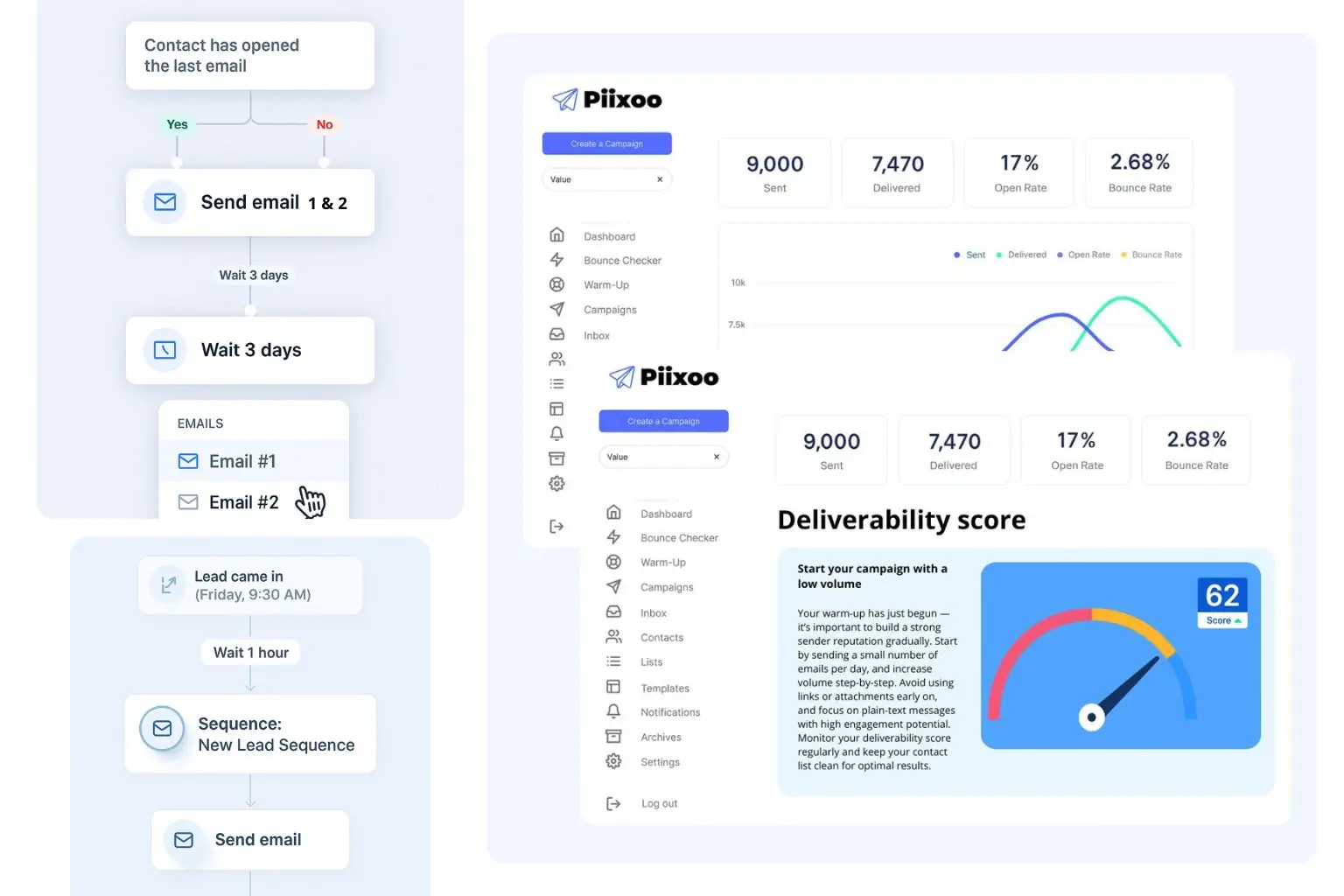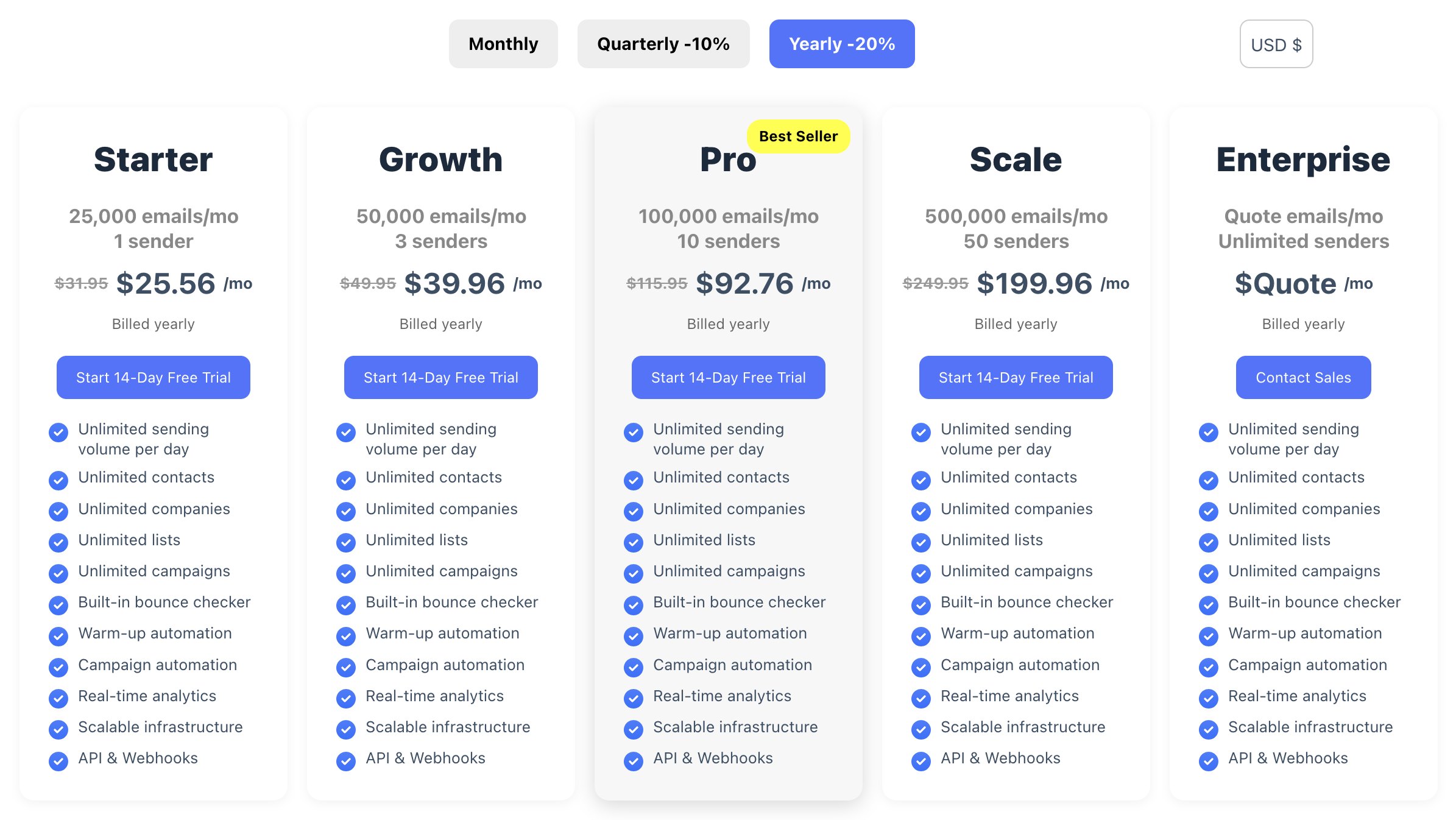Email automation software is no longer optional—it’s a critical lever for B2B companies across the US, Canada, UK, and Australia to scale efficiently while maintaining personalization and measurable ROI. Automation replaces manual outreach with trigger-based workflows—welcome sequences, nurture campaigns, re-engagement—that deliver timely, consistent messaging to buyers across long sales cycles. By freeing marketing and sales teams from repetitive tasks, it empowers them to focus on strategy, creativity, and pipeline acceleration. Piixoo
Definition for featured snippet: Email automation software uses triggers and workflows to send tailored, timely emails—like lead nurturing and re-engagement campaigns—automatically, enabling scalable, efficient communication that drives engagement and growth. (54 words)
👉 Start your 14-Day Free Trial
- Delivers high ROI across English-speaking B2B markets
- Enables personalization at scale in long sales cycles
- Frees up teams to focus on strategy and revenue growth
- Ensures consistency, compliance, and measurable performance
- Essential for scaling in 2026 and beyond
- Understand what Email automation software really does
- Discover quantified benefits for B2B businesses
- Follow a clear, market-aligned implementation path
- See top tools and how to choose among them
- Avoid typical pitfalls that derail ROI
- Get answers to your most burning questions
Definition & Context for Email Automation Software
Email automation software refers to platforms that automatically send emails based on predefined triggers—such as form submissions, website activity, or stage in the sales funnel. In 2025, over 63% of marketers are using automation for email marketing, making it the most automated channel across industries. For B2B, where the sales cycle spans weeks or months and decisions involve multiple stakeholders, automation ensures timely, relevant outreach without manual effort.
In markets like the US, Canada, UK, and Australia, automation also helps maintain compliance with evolving regulations—CAN-SPAM, CASL, GDPR—and supports mobile-first design, which is vital since many users will delete emails not optimized for mobile. A modern email automation platform typically includes consent capture, preferences centers, and suppression management to reduce risk.

- Automatic trigger-based sending (e.g., welcome, nurture, re-engagement)
- Integration with CRM and CDP drives personalized, data-driven campaigns
- Mobile-optimized templates ensure higher engagement across devices
- Built-in compliance tools simplify adherence to regional laws
Benefits of Email Automation Software
Email automation software delivers transformative benefits for B2B growth, especially in the US, Canada, UK, and Australia. First, it dramatically increases ROI: every $1 spent on email marketing returns strong average returns, and automated emails frequently generate significantly more revenue than non-automated messages. Second, optimized automations can deliver notably higher revenue per recipient for top-performing workflows versus average campaigns. Third, automation scales personalized engagement across long sales cycles, crucial for meaningful B2B conversions. When paired with a robust email automation platform, teams gain reliable attribution, faster testing cycles, and better forecasting.
- Unmatched ROI across priority markets—higher for optimized workflows
- Scalable personalization across long B2B cycles (US/CA/UK/AU)
- Higher revenue per recipient with lifecycle automation
- Improved engagement with mobile-responsive, timely sequences
- Better attribution and decision-making via automated analytics

How to Implement Email Automation Software Effectively
To scale your B2B business in 2026, follow a structured implementation plan tailored to the US, Canada, UK, and Australia markets. Begin with setting clear goals—lead nurturing, onboarding, upsell, or reactivation—and map those to your buyer journey. Then segment your list based on firmographics, behavior, or engagement level to ensure relevance. Next, choose an email automation platform that offers CRM integration, mobile-first templates, and compliance support. Build and test workflows, starting with a high-impact use case like welcome or nurture sequences, then measure, refine, and scale across other stages.
Step 1: Define Goals & Segment Your Audience
Start by pinpointing objectives—e.g., increasing SQL volume by 20%, reducing churn, or accelerating demo scheduling. Then segment your database by geography (US/CA/UK/AU), company size, vertical, or engagement behavior. Segmented programs consistently outperform broadcast sends. Align triggers to buyer intent and ensure your email automation software reflects consent status and frequency caps for each market.

Step 2: Select the Right Automation Platform
Choose a solution that integrates with your CRM or stack, offers customizable workflows, and mobile-responsive emails. Ensure compliance modules (e.g., CASL in Canada, GDPR in UK/AU, CAN-SPAM in US) are available. Tools that include AI-driven personalization or predictive segmentation deliver stronger pipeline velocity. Shortlist vendors whose email automation platform supports event streaming, robust APIs, and role-based permissions.
Step 3: Build, Test, Monitor, and Optimize
Launch a core workflow—like a welcome or lead nurture sequence. Use A/B tests on subject lines, content, timing, and call-to-action. Top-performing automations can generate substantially more per recipient than average. Monitor metrics like open rate, CTR, conversion, and influenced revenue. Iterate based on results, and add branches to support cold outreach follow-ups, SDR hand-offs, or product-qualified lead paths where appropriate.
- Do: localize content for each priority market (tone, compliance, timing)
- Don’t: treat all markets the same—avoid legal or cultural missteps
- Do: mobile-first design to reduce deletion rates
- Don’t: skip A/B testing—optimization compounds ROI
- Compliance tip: include proper opt-in/opt-out controls and physical address for US/AU law adherence
Tools & Resources to Scale Email Automation Software
Navigating the landscape requires knowing which tools fit your scale and market needs. Look for platforms offering CRM sync, advanced segmentation, AI testing, mobile templates, and compliance features. Adoption of email automation software continues to rise among B2B teams, and modern stacks increasingly favor solutions that unify messaging with sales workflows and analytics.
Tool 1: ActiveCampaign
ActiveCampaign integrates email, CRM, sales automation, and AI across the US, Canada, UK, and Australia. Its generative features simplify workflow creation and optimization for growing B2B teams, making it a strong candidate when assessing an email automation platform with CRM depth.
Tool 2: Mailmodo (or similar advanced ESP)
Mailmodo and similar providers excel in interactive, trigger-based workflows and pipeline attribution. They help operations teams visualize lifecycle gaps and accelerate testing, which is critical when scaling email automation software in complex buying cycles.
Tool 3: Omnisend / Guided ESPs
Omnisend is strong in multi-channel automation and demonstrates solid revenue-per-subscriber performance, particularly where email and SMS need to work together. For B2B, its segmentation and automation depth can complement your existing stack as a flexible email automation platform.
- Integration ease with CRMs and e-commerce systems
- Compliance modules (CASL, GDPR, CAN-SPAM support)
- AI-driven personalization and predictive analytics
- Mobile-responsive workflow templates
- Pricing scalability for SMB B2B needs
| Feature | Piixoo | Lemlist | Instantly | Humanlinker | Apollo.io | Waalaxy | Reply.io |
|---|---|---|---|---|---|---|---|
| Emails per day | ✅Unlimited | ❌250 max/day | ❌Limited (IP) | ❌600 max/day | ❌2,800 max/day | ❌500 max/day | ✅Limited* |
| Warmup | ✅Included | ❌Add-on | ❌Add-on | ❌None | ❌None | ❌None | ❌None |
| Bounce Checker | ✅Included | ❌None | ❌None | ❌200/mo max | ❌None | ❌None | ✅Available |
| Contacts | ✅Unlimited | ✅Unlimited | ✅Unlimited | ✅Unlimited | ❌Limited | ❌Limited | ❌1,000 active/mo |
| Campaigns | ✅Unlimited | ✅Unlimited | ✅Unlimited | ✅Unlimited | ❌Limited | ❌Limited | ✅Limited |
Common Mistakes to Avoid with Email Automation Software
Over-Automation Without Strategy
Automating without a defined goal or buyer journey often leads to generic, ineffective emails. Always start with a clear intent—like accelerating demo requests or reducing churn—and ensure your email automation software maps each message to a measurable outcome.
Ignoring Segmentation and Personalization
Sending the same content to all leads misses relevance and engagement. Segmented campaigns consistently drive higher revenue and satisfaction. Maintain dynamic fields and logic in your email automation platform to serve content based on behavior and profile.
Skipping A/B Testing
Not testing subject lines, timing, and creative can leave ROI gains on the table. Establish a testing calendar and document learnings so improvements compound. Where appropriate, pair nurture streams with compliant cold outreach cadences to accelerate feedback.
- Ensure every workflow supports a measurable business goal
- Regularly refresh segments to reflect behavior shifts
- Test and compare performance across US/CA/UK/AU audiences
- Use compliance checklists for each region’s regulations
- Monitor deliverability—adjust naming, frequency, and content accordingly
Frequently Asked Questions
Why use Email Marketing Automation?
Automation delivers personalized, timely outreach at scale—freeing teams from manual tasks and driving significantly better ROI compared to many channels. Pairing an email automation platform with strong segmentation enables consistent nurture across complex B2B journeys.
- Scale personalized messaging without increasing workload
- Consistent nurture across long B2B cycles
- High ROI leveraged with automation
How does an Email Automation Platform work?
An email automation platform triggers emails based on user actions—like sign-ups, webinar attendance, or inactivity—using workflows defined by the marketer, integrated with CRM data and analytics for automation and optimization across the funnel.
- Identifies user behavior triggers
- Sends tailored sequences according to workflow logic
- Tracks performance (opens, clicks, revenue) for iteration
Why scale using a Cold Outreach Prospecting Tool?
For B2B sales, cold outreach tools automate manual prospecting with personalization—scaling outreach while ensuring relevance. Combining SDR sequences with marketing nurture helps maintain context from first touch to opportunity and complements a prospecting tool inside your CRM.
- Automates repetitive outreach tasks
- Maintains message relevance via templates and personalization
- Tracks responses and workflows into CRM for follow-up
What benefits does Sales Enablement Automation bring?
Sales enablement automation aligns email workflows with buyer readiness. It delivers prospect-tailored content at the right stage—improving conversion rates and accelerating deals. When connected to enablement content, your email automation software becomes a practical sales enablement tool.
- Delivers content aligned to buyer journey stage
- Improves lead scoring and follow-up timing
- Empowers sales with consistent nurture touchpoints
Why is Piixoo the best B2B Email Automation Tool to grow my sales?
Piixoo combines CRM-aligned workflow automation, personalization, and compliance modules tailored for US, Canada, UK, and Australia markets—designed to minimize friction and maximize pipeline conversion. It also supports cold outreach alignment where appropriate through integrations.
- Built-in compliance for CAN-SPAM, CASL, GDPR
- Optimized templates for mobile-first design
- Focus on B2B workflow performance and revenue growth
What mistakes should I avoid with an Email Automation Tool?
Avoid generic bulk campaigns, over-emailing, ignoring segmentation, and neglecting testing. These practices lower engagement and ROI. Instead, tailor, monitor, and iterate—treat your email automation software as a continuous improvement engine.
- Don’t send too frequently—risk fatigue
- Don’t bypass testing—ROI declines dramatically
- Don’t ignore deliverability signals—monitor bounces and spam flags
Why do Email Automation Platforms generate the best ROI?
Automated workflows deliver messages at the right moment, with relevant content—yielding materially higher revenue than one-off campaigns. With lifecycle targeting, testing, and data sync, an email automation platform compounds performance over time.
- Superior timing and relevance
- Lower marginal cost per send
- Persistent refinement through testing
Conclusion
Email automation software is indispensable for scaling B2B businesses in 2026 across the US, Canada, UK, and Australia. With personalized workflows, measurable ROI, and compliance baked in, it transforms outreach into a strategic engine. Start by defining your goals, selecting the right tool, building tested workflows, and iterating based on performance.
👉 One Subscription. All the Tools. Zero Add-Ons.
- Define one high-impact automation goal (e.g., nurture leads)
- Segment your list by key markets and buyer stages
- Select a compliant, mobile-first platform
- Launch, test, and optimize one workflow at a time
- Scale successful tests to more stages or markets

